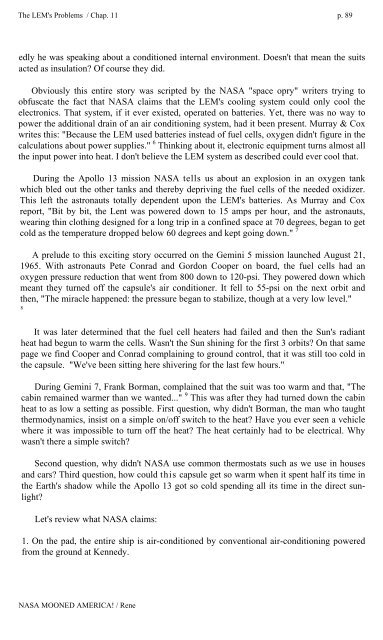Rene-NASA-Mooned-America
Rene-NASA-Mooned-America
Rene-NASA-Mooned-America
You also want an ePaper? Increase the reach of your titles
YUMPU automatically turns print PDFs into web optimized ePapers that Google loves.
The LEM's Problems / Chap. 11 p. 89<br />
edly he was speaking about a conditioned internal environment. Doesn't that mean the suits<br />
acted as insulation Of course they did.<br />
Obviously this entire story was scripted by the <strong>NASA</strong> "space opry" writers trying to<br />
obfuscate the fact that <strong>NASA</strong> claims that the LEM's cooling system could only cool the<br />
electronics. That system, if it ever existed, operated on batteries. Yet, there was no way to<br />
power the additional drain of an air conditioning system, had it been present. Murray & Cox<br />
writes this: "Because the LEM used batteries instead of fuel cells, oxygen didn't figure in the<br />
calculations about power supplies." 6 Thinking about it, electronic equipment turns almost all<br />
the input power into heat. I don't believe the LEM system as described could ever cool that.<br />
During the Apollo 13 mission <strong>NASA</strong> tells us about an explosion in an oxygen tank<br />
which bled out the other tanks and thereby depriving the fuel cells of the needed oxidizer.<br />
This left the astronauts totally dependent upon the LEM's batteries. As Murray and Cox<br />
report, "Bit by bit, the Lent was powered down to 15 amps per hour, and the astronauts,<br />
wearing thin clothing designed for a long trip in a confined space at 70 degrees, began to get<br />
cold as the temperature dropped below 60 degrees and kept going down." 7<br />
A prelude to this exciting story occurred on the Gemini 5 mission launched August 21,<br />
1965. With astronauts Pete Conrad and Gordon Cooper on board, the fuel cells had an<br />
oxygen pressure reduction that went from 800 down to 120-psi. They powered down which<br />
meant they turned off the capsule's air conditioner. It fell to 55-psi on the next orbit and<br />
then, "The miracle happened: the pressure began to stabilize, though at a very low level."<br />
8<br />
It was later determined that the fuel cell heaters had failed and then the Sun's radiant<br />
heat had begun to warm the cells. Wasn't the Sun shining for the first 3 orbits On that same<br />
page we find Cooper and Conrad complaining to ground control, that it was still too cold in<br />
the capsule. "We've been sitting here shivering for the last few hours."<br />
During Gemini 7, Frank Borman, complained that the suit was too warm and that, "The<br />
cabin remained warmer than we wanted..." 9 This was after they had turned down the cabin<br />
heat to as low a setting as possible. First question, why didn't Borman, the man who taught<br />
thermodynamics, insist on a simple on/off switch to the heat Have you ever seen a vehicle<br />
where it was impossible to turn off the heat The heat certainly had to be electrical. Why<br />
wasn't there a simple switch<br />
Second question, why didn't <strong>NASA</strong> use common thermostats such as we use in houses<br />
and cars Third question, how could this capsule get so warm when it spent half its time in<br />
the Earth's shadow while the Apollo 13 got so cold spending all its time in the direct sunlight<br />
Let's review what <strong>NASA</strong> claims:<br />
1. On the pad, the entire ship is air-conditioned by conventional air-conditioning powered<br />
from the ground at Kennedy.<br />
<strong>NASA</strong> MOONED AMERICA! / <strong>Rene</strong>


